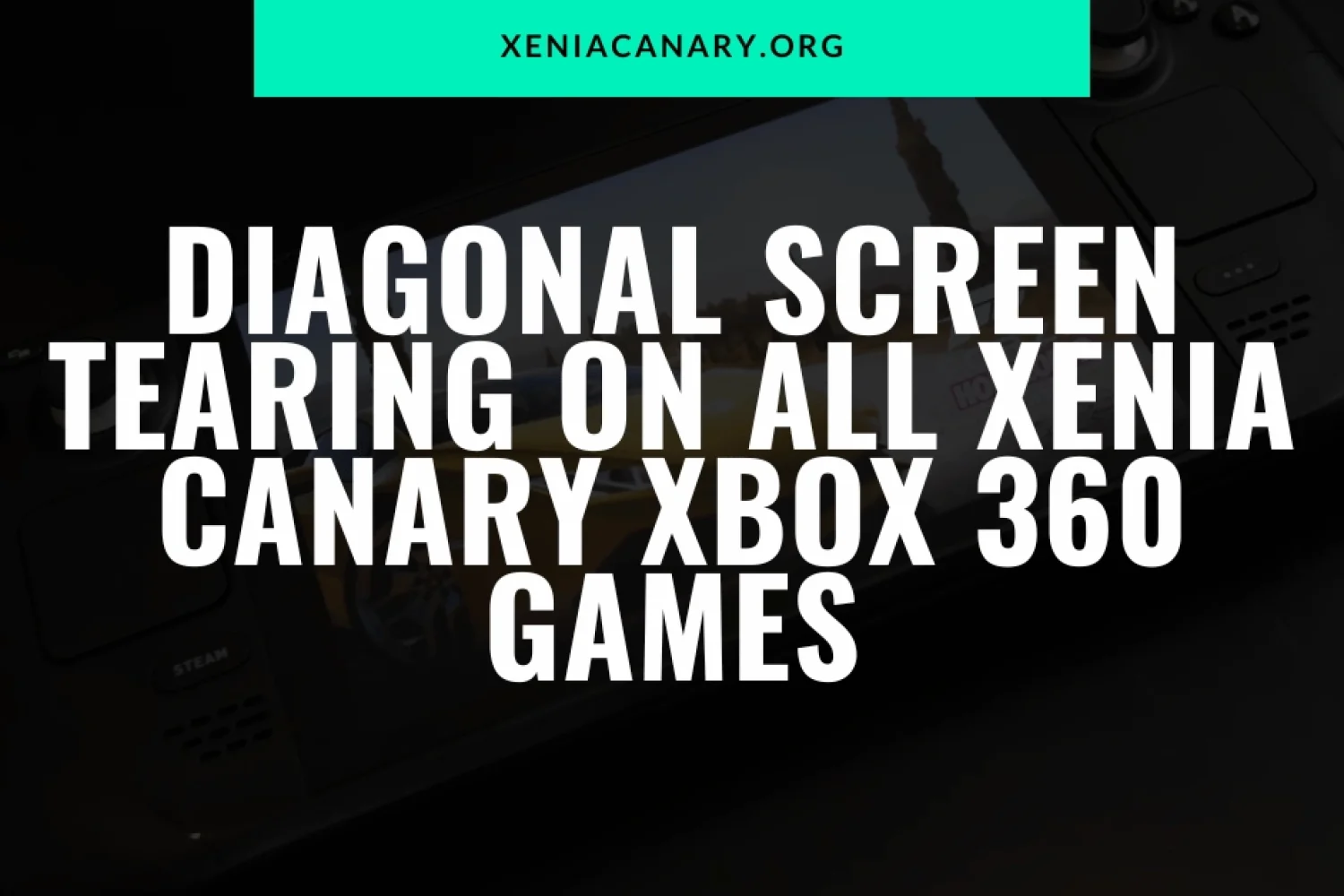Introduction
Xenia Canary, an emulator renowned for its ability to replicate Xbox 360 games on PC platforms, offers gamers a gateway to relive classic titles. However, despite its advancements, users frequently encounter an annoying issue: diagonal screen tearing. This phenomenon manifests as disruptive, jagged lines appearing across the screen during gameplay, significantly detracting from the immersive experience.
In this discussion, we delve into the intricacies of this persistent problem, exploring its root causes and potential solutions.

Possible causes of Diagonal Screen tearing
Inadequate synchronization between the emulator and the display hardware: One of the primary causes of screen tearing in emulators like Xenia Canary is the lack of synchronization between the emulator’s frame rendering and the display’s refresh rate.
Emulators often render frames asynchronously, meaning they don’t wait for the monitor’s vertical refresh cycle to start drawing a new frame. As a result, when a frame is displayed in the middle of rendering, it can cause tearing. To mitigate this issue, enabling Vsync (Vertical Synchronization) can help synchronize the frame rate with the monitor’s refresh rate, reducing or eliminating screen tearing.
GPU driver issues:
Outdated or incompatible GPU drivers can lead to various graphical glitches, including screen tearing. It’s essential to ensure that your GPU drivers are up to date-and compatible with the version of the emulator you’re using. Updated drivers often include optimizations and bug fixes that can improve GPU performance and stability, reducing the likelihood of screen tearing.
Emulation software bugs:
Emulators, especially those for complex systems like the Xbox 360, are prone to bugs and glitches that can affect graphical output. Screen tearing can sometimes result from bugs in the emulation software itself, such as incorrect frame timing or rendering processes. Developers of emulators like Xenia continually work to improve compatibility and performance, but some issues may persist, especially in newer or less well-supported games.
Incompatibility with specific game titles:
Certain games may exhibit screen tearing more prominently due to their particular rendering techniques or demands on the emulator. Some games may require specific emulation settings or workarounds to reduce or eliminate tearing effectively. Additionally, games with varying frame rates or irregular rendering patterns may be more prone to screen tearing, especially if the emulator struggles to maintain consistent performance Diagonal Screen tearing.
Troubleshooting steps
Here are detailed troubleshooting steps to resolve diagonal screen tearing issues while using the Xenia Canary emulator. Ensure your settings align with the optimal configuration for games included in the Xenia Canary game list.
Update GPU drivers to the latest version:
- Visit the website of your GPU manufacturer (such as NVIDIA, AMD, or Intel) and download the latest drivers for your graphics card model.
- Install the updated GPU drivers following the manufacturer’s instructions.
- Updated drivers often include optimizations and bug fixes that can improve GPU performance and stability, potentially reducing screen tearing in the emulator.
Check for updates or patches for Xenia Canary:
- Regularly check for updates to the Xenia Canary emulator.
- Developers often release updates to address bugs, improve compatibility, and enhance performance.
- Visit the official Xenia GitHub repository or community forums to download the latest version or check for patch notes detailing fixes for known issues, including Diagonal Screen tearing.
Adjust emulator settings:
- Explore the settings menu within the Xenia Canary emulator.
- Look for options related to graphics rendering, synchronization, and frame rate limiting.
- Enable Vsync (Vertical Synchronization) to synchronize the emulator’s frame rate with your monitor’s refresh rate. This can help reduce or eliminate screen tearing.
- Experiment with different frame rate limiters to stabilize frame delivery and prevent tearing.
- Some emulators offer specific settings or options tailored to address screen tearing issues. Look for any such options in the emulator’s configuration menu.
Verify compatibility of games with the emulator:
- Check the compatibility list on the Xenia emulator’s website or community forums to see if the games you’re experiencing issues with are fully supported.
- Some games may have specific compatibility issues or require additional settings to run correctly without graphical glitches, including Diagonal Screen tearing.
- If a game is listed as “playable” but still exhibits screen tearing, search for user-reported issues or workarounds specific to that title, such as XCloud vs Xenia Canary.
Search online forums or communities for similar issues and potential solutions:
- Browse forums, subreddits, and other online communities dedicated to emulation or Xbox 360 gaming.
- Look for threads discussing screen tearing issues in Xenia Canary or similar emulators.
- Users often share their experiences and troubleshooting tips, including settings tweaks and workarounds to mitigate screen tearing Diagonal Screen tearing.
Engage with the community by posting about your specific issue and asking for advice. Other users may offer helpful suggestions or point you toward relevant resources.
Conclusion
In conclusion, addressing diagonal screen tearing in Xbox 360 games on the Xenia Canary emulator requires a systematic approach, including updating GPU drivers, checking for emulator updates, adjusting settings, verifying game compatibility, and seeking help from online communities. By following these steps, users can improve their gaming experience and minimize screen tearing, ultimately enjoying smoother and more immersive gameplay.
FAQs
Q: How can I reduce screen tearing in Xbox 360 games on the Xenia Canary emulator?
A: You can reduce screen tearing by updating your GPU drivers, checking for emulator updates, adjusting settings like Vsync and frame rate limiters, verifying game compatibility, and seeking help from online communities for specific solutions.
Q: What is Vsync, and how does it help reduce screen tearing?
A: Vsync (Vertical Synchronization) synchronizes the frame rate of the emulator with the refresh rate of your monitor, preventing the display from showing incomplete frames and Diagonal Screen tearing.
Q: How do I know if my GPU drivers are up to date?
A: You can check for updates on the website of your GPU manufacturer (such as NVIDIA, AMD, or Intel). Download and install the latest drivers compatible with your graphics card model.
Q: Where can I find updates or patches for the Xenia Canary emulator?
A: Updates or patches for the Xenia Canary emulator can be found on its official GitHub repository or community forums. Check regularly for new releases and follow instructions for updating the emulator.
Q: Are there specific emulator settings I should adjust to reduce Diagonal Screen tearing?
A: Yes, adjusting settings like Vsync, frame rate limiters, and graphics options within the emulator can help reduce Diagonal Screen tearing. Experiment with different settings to find the optimal configuration for your system.
Q: What should I do if a game exhibits screen tearing despite being listed as compatible with the emulator?
A: If a game still shows Diagonal Screen tearing issues despite being listed as compatible, search for user-reported issues or workarounds specific to that title. Online forums and communities dedicated to emulation can provide valuable insights and solutions.
Latest Post


